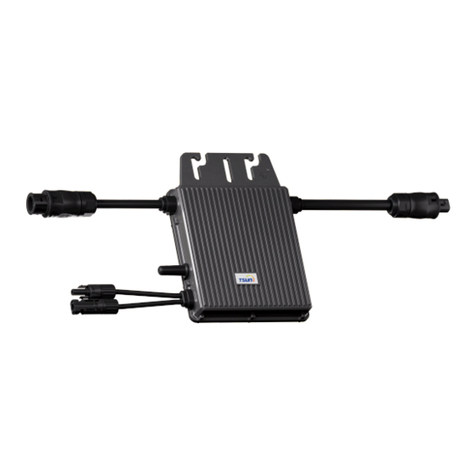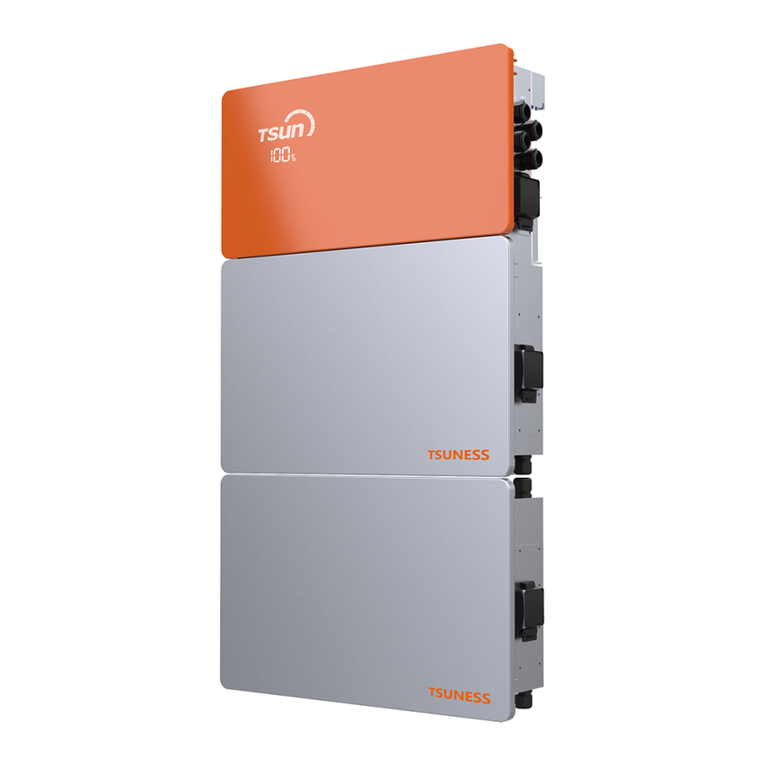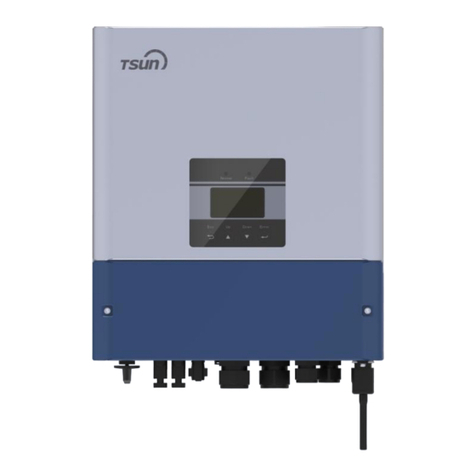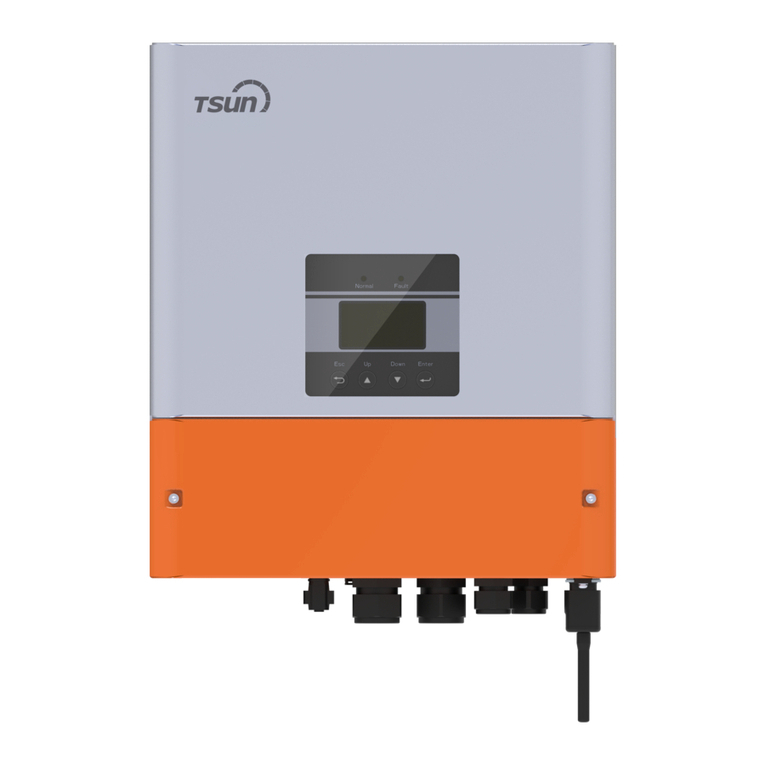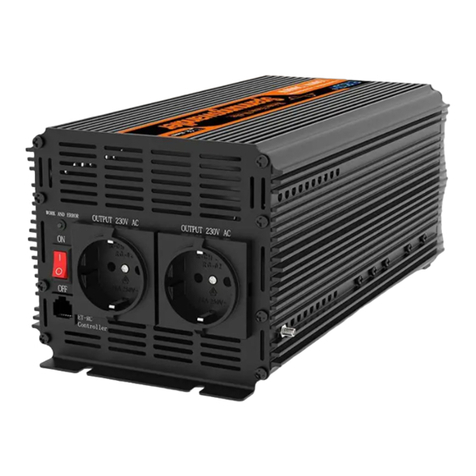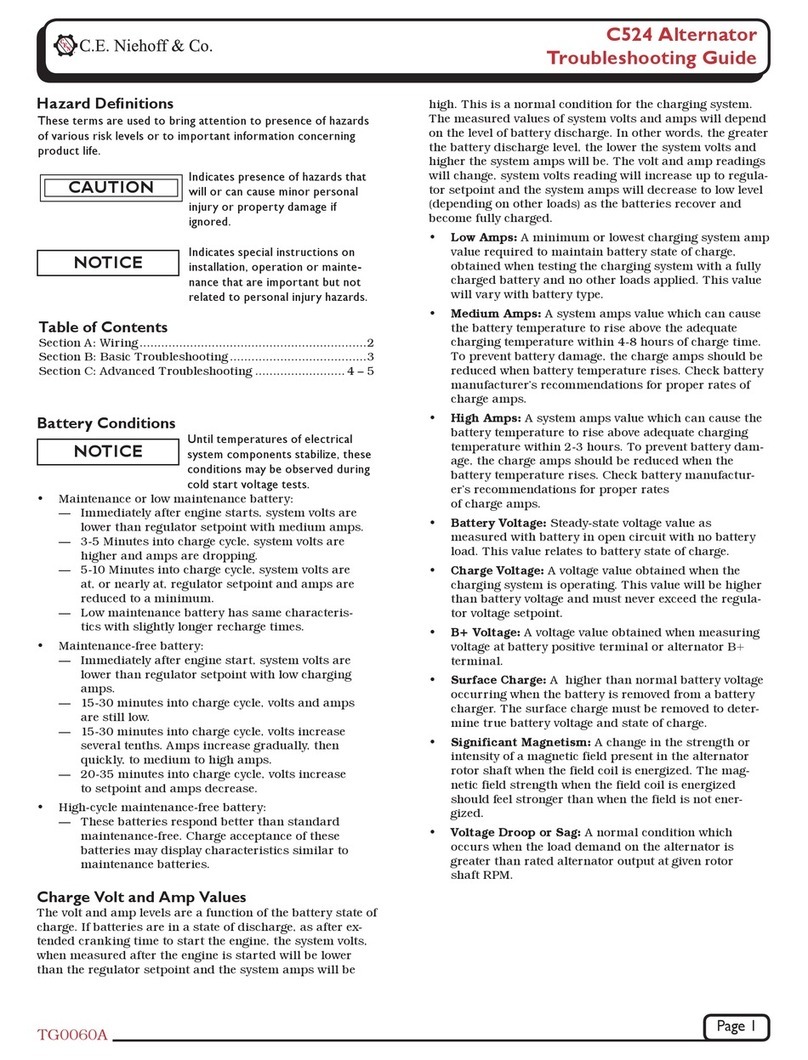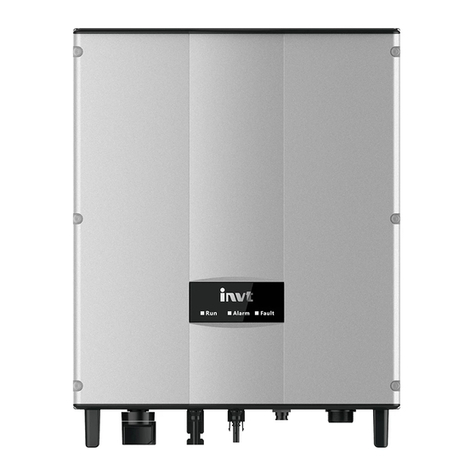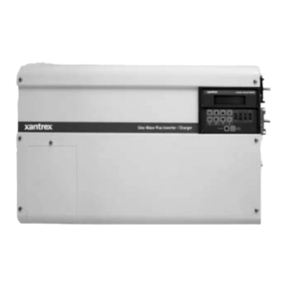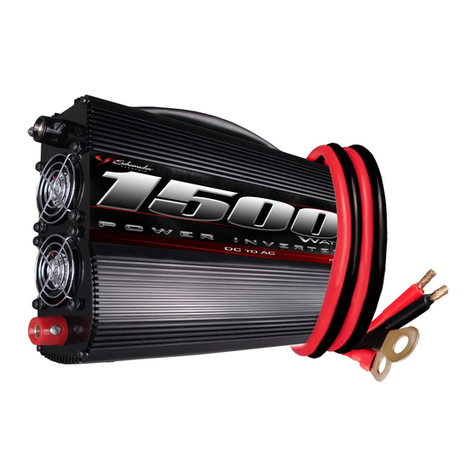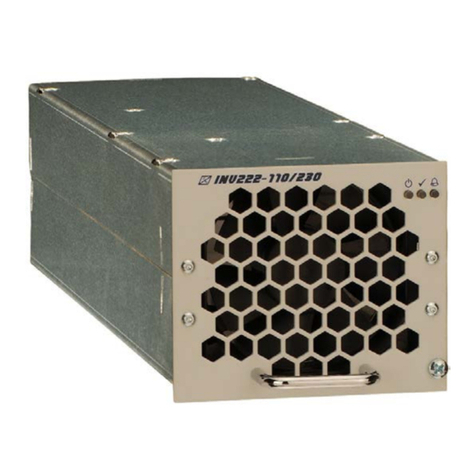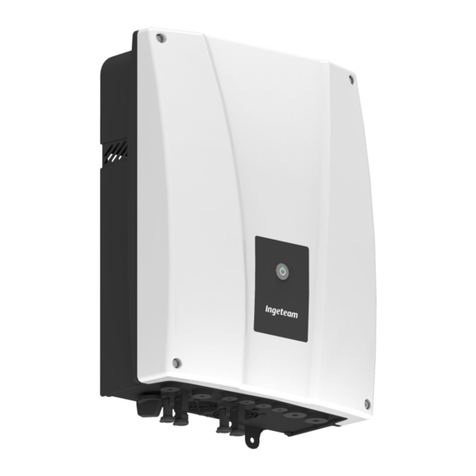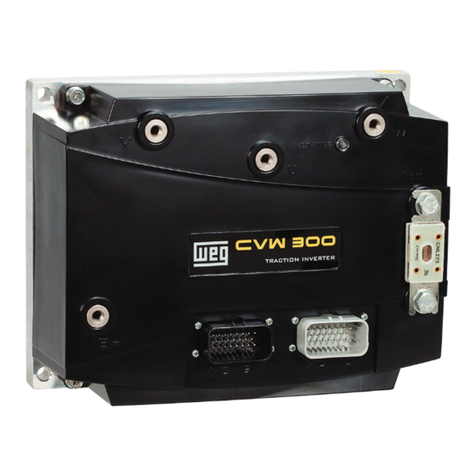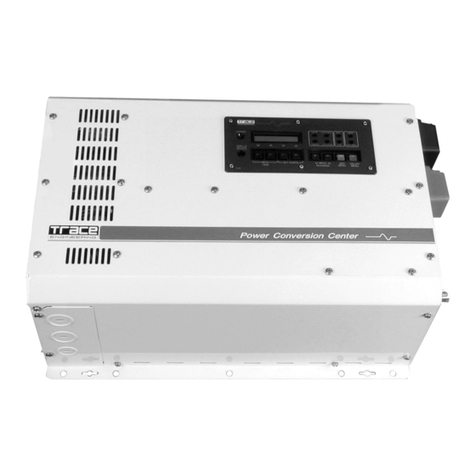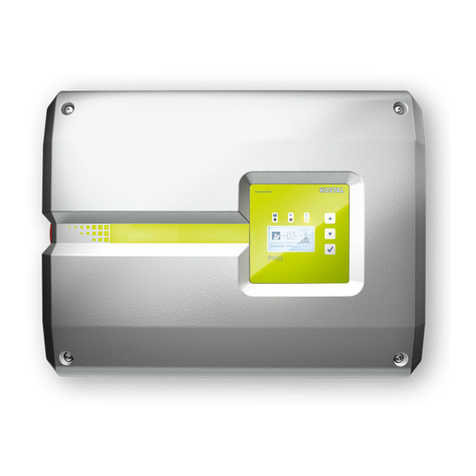TSUNESS TSOL-H3.0K-S User manual

-
1 -
TSOL-H3.0K-S
TSOL-H3.6K-S
TSOL-H4.0K-S
TSOL-H4.6K-SE
TSOL-H5.0K-SE
TSOL-H6.0K-SE
TSOL-H4.6K-S
TSOL-H5.0K-S
TSOL-H6.0K-S

-
2 -
Content
1 Safety Precautions ........................................................................................................................................................................ - 3 -
1.1 Scope of Application.............................................................................................................................................................................................- 3 -
1.2 Safety Instructions................................................................................................................................................................................................- 3 -
1.3 Target Group.........................................................................................................................................................................................................- 3 -
2 Preparation.................................................................................................................................................................................... - 4 -
2.1 Safety Instructions................................................................................................................................................................................................- 4 -
2.2 Explanations of Symbols ......................................................................................................................................................................................- 5 -
3 Product Information...................................................................................................................................................................... - 6 -
3.1 Application Scope of Products..............................................................................................................................................................................- 6 -
3.2 Specification for Product Model...........................................................................................................................................................................- 6 -
3.3 Overview and Dimensions of products.................................................................................................................................................................- 6 -
3.4 Datasheet ..............................................................................................................................................................................................................- 7 -
4 Instructions for installation..........................................................................................................................................................- 11 -
4.1 Safety Instructions..............................................................................................................................................................................................- 11 -
4.2 Pre-installation Check.........................................................................................................................................................................................- 11 -
4.3 The Determination of the Installation Method and Position................................................................................................................................- 11 -
4.4 Mounting Procedure ...........................................................................................................................................................................................- 12 -
5 Electrical Connection.................................................................................................................................................................. - 15 -
5.1 Safety Instruction for Hot-line Job......................................................................................................................................................................- 15 -
5.3 AC grid wire and backup output Connection ......................................................................................................................................................- 16 -
5.4 PV Connection....................................................................................................................................................................................................- 18 -
5.5 Battery connection..............................................................................................................................................................................................- 20 -
5.6 Communication Connection ...............................................................................................................................................................................- 21 -
5.7 Smart Meter Connection.....................................................................................................................................................................................- 22 -
5.8 Ground Connection.............................................................................................................................................................................................- 24 -
6 Debugging Instructions............................................................................................................................................................... - 26 -
6.1 Introduction of Human-computer Interface.........................................................................................................................................................- 26 -
6.2 First Run Setup...................................................................................................................................................................................................- 27 -
6.3 Main Interface.....................................................................................................................................................................................................- 28 -
6.4 Menu List............................................................................................................................................................................................................- 32 -
7 Fault Code and Troubleshooting................................................................................................................................................. - 45 -
8. Recycling and Disposal ............................................................................................................................................................. - 48 -
9. Guarantee Service...................................................................................................................................................................... - 48 -

-
3 -
1 Safety Precautions
1.1 Scope of Application
This User Manual describes instructions and detailed procedures for installing, operating, maintaining, and
troubleshooting of the following TSUN hybrid solar inverters:
TSOL-H3.0K-S TSOL-H3.6K-S TSOL-H4.0K-S
TSOL-H4.6K-S TSOL-H5.0K-S TSOL-H6.0K-S
TSOL-H4.6K-SE TSOL-H5.0K-SE TSOL-H6.0K-SE
Please keep this manual all time available in case of emergency.
1.2 Safety Instructions
DANGER
· DANGER indicates a hazardous situation which, if not avoided, will result in death or
serious injury.
WARNING
· WARNING indicates a hazardous situation which, if not avoided, can result in death or
serious injury or moderate injury.
CAUTION
· CAUTION indicates a hazardous condition which, if not avoided, can result in minor or
moderate injury.
NOTICE
· NOTICE indicates a situation that can result in potential damage, if not avoided.
1.3 Target Group
Only qualified electricians who have read and fully understood all safety regulations contained in this manual
can install, maintain and repair the inverter. Operators must be aware of the high-voltage device.

-
4 -
2 Preparation
2.1 Safety Instructions
DANGER
· There is possibility of dying due to electrical shock and high voltage.
· Do not touch the operating component of the inverter, it might result in burning or death.
· To prevent risk of electric shock during
installation and maintenance, please make sure that
all AC and DC terminals are plugged out.
· Do not touch the surface of the inverter while the housing is wet, otherwise, it might cause
electrical shock.
· Do not stay close to the inverter while there a
re severe weather conditions including storm,
lighting, etc.
· Before opening the housing, the TSUN inverter
must be disconnected from the grid and PV
generator; you must wait for at least five minutes to let the energy storag
e capacitors
completely discharged after disconnecting from power source.
WARNING
·The installation, service, recycling and disposal of the inverters must be performed by
qualified personnel only in compliance with national and local standards and regulations.
·Any unauthorized ac
tions including modification of product functionality of any form may
cause lethal hazard to the operator, third parties, the units or their property. TSUN
is not
responsible for the loss and these warranty claims.
·The TSUN inverter must only be operated
with PV generator. Do not connect any other
source of energy to the TSUN inverter.
·Be sure that the PV generator and inverter are well grounded in order to protect properties and
persons.
CAUTION
·The inverter will become hot during operation. Please do not touch the heat sink or peripheral
surface during or shortly after operation.
·Risk of damage due to improper modifications.
NOTICE
·Public utility only.
·The inverter is designed to feed AC power directly to the public utility power grid; do n
ot
connect AC output of the inverter to any private AC equipment.

-
5 -
2.2 Explanations of Symbols
Symbol
Description
Dangerous electrical voltage
This device is directly connected to public grid, thus all
work to the
inverter shall only be carried out by qualified personnel.
Danger to life due to high electrical voltage!
There might be residual currents in inverter because of
large capacitors.
Wait 5 MINUTES before you remove the front lid.
Notice, danger!
This is directly connected with electricity generators and public grid.
Danger of hot surface
The components inside the inverter will release a lot of
heat during
operation. Do not touch metal plate housing during operating.
An error has occurred
Please go to Chapter 9 “Troubleshooting” to remedy the error.
This device SHALL NOT be disposed of in residential waste
Please go to Chapter 8 “Recycling and Disposal” for proper treatments.
Without Transformer
This inverter does not use transformer for the isolation function.
CE Mark
With CE mark & the inverter fulfills the basic requirements of the
Guideline Governing Low-Voltage and Electro-magnetic Compatibility.
RCM Mark
Equipment meets safety and other requirements as required
by electrical
safety laws/regulations in Australian and New Zealand.
No unauthorized perforations or modifications
Any unauthorized perforations or modifications are
strictly forbidden, if
any defect or damage (device/person) occurred, TSUN shall not take any
responsibility for it.

-
6 -
3 Product Information
3.1 Application Scope of Products
TSOL-H series products are hybrid solar inverters without transformers, and the inverters are important
components of energy storage systems.
The TSOL-H inverters converts the DC generated by solar panels into AC which is in accordance with the
requirements of public grid and send the AC into the grid, reduce the load pressure of the grid.
When the grid failure, provide AC source to supply important loads, achieve uninterrupted power supply
function.
3.2 Specification for Product Model
TSOL -H 3.0K -S E
①②③
①H represents for hybrid inverter.
②X.XK represents rated power XkW of inverter, for example 3.0K means 3kW.
③S means 48 V standard battery voltage, E means economical.
3.3 Overview and Dimensions of products
The dimensions of TSOL-H series products is shown in Figure 3.1.
Figure 3.1 Dimensions of TSOL-H series Product

-
7 -
3.4 Datasheet
MODEL TSOL-
H3.0K-S
TSOL-
H3.6K-S
TSOL-
H4.0K-S
TSOL-
H4.6K-SE
TSOL-
H5.0K-SE
TSOL-
H6.0K-SE
Input(DC)
Max.PVArray Power[Wp]@STC 4500 5400 6000 6900 7500 9000
Max. DC Voltage [V] 600
MPPT Voltage Range [V] 90~550
Nominal DC Voltage[V] 360
Start Voltage [V] 120
Min. DC Voltage [V] 80
Max. DC Input Current[A] 12.5 / 12.5
Max. DC Short Current[A] 15 / 15
Number of MPPT
2
DC Switch Integrated
Battery Data
Battery Type Lithium battery
Battery Input Voltage
/Range of Voltage [V]
48 / 42~58.4
Max./Rated Charge Current [A] 60/60
Battery Capacity [AH] 50~2000
Charging Mode Control 2-stages
Grid Data [On grid Mode]
Rated Output Power[W] 3000 3680 4000 4600 5000*1 6000
Max. Output Power [W] 3000 3680 4000 4600 5000 6000
Rated Output Current [A] 13.1 16.0 17.4 20 21.8*2 26.1
Max. Output Current [A] 13.6 16.7 18.2 20.9 22.7 27.3
Rated Grid voltage /Range [V] 220V, 230V, 240V / 180V~280V
Rated Grid Frequency / Range [Hz] 50 / 60 ± 5
Power Factor [cos φ] 0.8 leading~0.8 lagging
Total Harmonic Distortion [THDi] <3%
Feed-in L+N+PE
AC Output Data [Back-up Mode]
Rated Output Power [W] 3000
Output Voltage [V] 220/230/240
Output Frequency [Hz] 50/60
Total Harmonic Distortion of Voltage <3%
Peak OutputApparent Power [VA] 3600, 10sec
Efficiency
Max. Efficiency 97.6%

-
8 -
Euro Efficiency 97.0%
Max. Battery to Load Efficiency 94.6%
Protection
AC Short Circuit Protection Integrated
Overload Protection Integrated
DC Overvoltage/
Integrated
AC Overvoltage/
Integrated
AC Overfrequency/
Integrated
Over Thermal Protection Integrated
Anti-islanding protection Integrated
Peak-to-trough Period Setting Integrated
Interface
PV Connection Type MC4
Battery Connection Type Terminal Block
AC Connection Type Terminal Block
Display LCD
Communication port RS485*2& RS232&DRM*2(Integrated)
Communication Mode Wi-Fi/GPRS/Ethernet(Optional)
General Data
Topology Transformerless
Ingress Protection IP65
Operating Temperature Range -25~+60℃[45~60℃with derating]
Ambient Humidity 0~100% No Condensing
Altitude 4000m(>3000m power derating)
Noise[dBA] <29
Cooling method Natural Convection
Dimensions[H*W*D][mm] 520*470*190
Weight[kg] 23
Standard Warranty[year] 5
Applicable Standard IEC/EN62109-1/2, EN61000-6-2/3, VDE-AR-N 4105, RD1699, UNE 206006,
UNE 206007, UTE C15-712-1, EN50549, CEI-021

-
9 -
MODEL
TSOL-H4.6K-S TSOL-H5.0K-S TSOL-H6.0K-S
Input (DC)
Max. PV Array Power [Wp]@STC
6900 7500 9000
Max. DC Voltage [V]
600
MPPT Voltage Range [V]
90-550
Nominal DC Voltage [V]
360
Start Voltage[V]
120
Min. DC Voltage[V]
80
Max. DC Input Current [A]
12.5 / 12.5
Number of MPPT
2
Number of DC Connection Sets per
MPPT
1/1
DC Switch
Integrated
Battery Parameters
Battery type Lithium battery
Rated Input Voltage/Voltage Range
[V] 48/42~58.4
Max/Rated Charging Current [A] 100/100
Battery Capacity [AH] 50-2000
Charging Mode Control 2-stages
Output (AC)
Rated AC Power [VA]
4600 5000 6000
Max. AC Apparent Power [VA]
4600 5000 6000
Rated AC Current [A]
20 21.8 26.1
Max. AC Current [A]
20.9 22.7 27.3
Nominal AC voltage/ range[V]
L/N/PE, 220/230/240V;180V-280V
Grid frequency/ range [Hz]
50Hz,60Hz /45Hz-55Hz,55-65Hz
Power factor, adjustable
0.8 leading~0.8 lagging
Total Harmonic Distortion (THDi)
< 3% (at nominal power)
Feed-in Grid
L+N+PE
AC Output [Back-up Mode]
Max. Output Power [VA] 4600 5000
Output Voltage [V] 220/230/240
Output Frequency [Hz] 50/60
Total Harmonic Distortion of
Voltage < 3%
Peak Output Apparent Power [VA] 5500 ,10sec 6000 ,10sec
Efficiency
Max. Efficiency
97.6%

-
10
-
Euro Efficiency
97.0%
Max. Battery to Load Efficiency
94.6%
Protection
AC Short-circuit Protection Integrated
Overload Protection Integrated
DC Overvoltage/
Undervoltage Protection Integrated
AC Overvoltage/
Undervoltage Protection Integrated
AC Over frequency/
Under frequency Integrated
Over Thermal Protection Integrated
Island Protection Integrated
Peak-to-trough Period Setting Integrated
Interface
DC Connection
MC4
Battery Connection Terminal Block
AC Connection Terminal Block
LCD Display
LCD Display
Communication
WiFi/GPRS
General Data
Operating Temperature Range
-25°C to +60°C ( >45°C derating)
Cooling Method
Natural Convection
Ambient Humidity
0% to 100% Non-condensing
Altitude
4000m(>3000m power derating)
Noise [dBA]
<29
Ingress Protection
IP65 (Indoor & Outdoor Installation)
Mounting
Rear Panel
Dimensions[H*W*D][mm] 470 * 400 * 190
Net Weight [kg]
23
Standard Warranty [Year]
5
Applicable Standard
IEC/EN62109-1/2, EN61000-6-2/3, VDE-AR-N 4105, RD1699, UNE 206006,
UNE 206007, UTE C15-712-1, EN50549, CEI-021

-
11
-
4 Instructions for installation
4.1 Safety Instructions
DANGER
· Dangerous to life due to potential fire or electricity shock.
· Do not install the inverter near any inflammable or explosive items.
· This inverter will be directly connected with HIGH VOLTAGE power generation device; the
installation must be performed by
qualified personnel only in compliance with national and
local standards and regulations.
NOTICE
· This equipment meets the pollution degree II.
· Inappropriate or the harmonized installation environment may jeopardize
the life span of the
inverter.
· Installation directly exposed under intensive sunlight is not recommended.
· The installation site must be well ventilated.
4.2 Pre-installation Check
4.2.1 Check the Package
Although TSUN’s inverters have surpassed stringent testing and are checked before they leave the factory, it is
uncertain that the inverters may suffer damages during transportation. Please check the package for any
obvious signs of damage, and if such evidence is present, do not open the package and contact your dealer as
soon as possible.
4.2.2 Check the Assembly Parts
Please refer to the Packing List inside the package container.
4.3 The Determination of the Installation Method and Position
4.3.1 Mounting Method
Please mount the inverter correctly as shown in Figure 4.1 below.
Figure 4.1 Mounting Method

-
12
-
(1) The equipment employs natural convection cooling, and it can be installed indoor or outdoor.
(2) Please install the equipment under the guidance of Figure4.1. Vertical installation on floor level is
recommended. Mount vertically or tilted backwards by max. 15°. Never install the inverter tilted forwards,
sideways, horizontally or upside down.
(3) Install the inverter at eye level for convenience when checking the LCD display and possible maintenance
activities.
(4) When mounting the inverter, please consider that disassembly for service work may be required.
4.3.2 Installation Position
Do not expose the inverter to direct solar irradiation as this could cause power derating due to overheating. The
ambient temperature should be between -25°C ~+60°C(-13° F ~140° F)to ensure optimum operation.
Choose locations with sufficient air exchange. Ensure additional ventilation, if necessary.
To make sure the installation spot is suitably ventilated, if multiple TSUN hybrid solar inverters are
installed at same area, the following safety clearance in Figure 4.2 shall be followed.
50CM
30CM
50CM
30CM
30CM
Figure 4.2 Minimum Clearance
4.4 Mounting Procedure
4.4.1 Mark the Positions of the Drill Holes of the Rear Panel
The mounting position should be marked as shown in Figure 4.3.

-
13
-
Figure 4.3 Dimensions of rear panel of TSOL-H inverter
4.4.2 Drill Holes and Place the Expansion Tubes
Following the given guides, drill 4 holes in the wall (in conformity with position marked in Figure 4.4, and
then place expansion tubes in the holes using a rubber mallet.
380
160
Ø8
Figure 4.4 Drill holes dimensions of TSOL-H inverter
4.4.3 Mount the Screws and the Rear Panel
The panels should be mounted in the mounting position by screws as shown in Figure 4.5.

-
14
-
Figure 4.5 Mount the Rear Panel of TSOL-H inverter
4.4.4 Mount the Inverter
Carefully mount the inverter to the rear panel as shown in Figure 4.6. Make sure that the rear part of the
equipment is closely mounted to the rear panel.
Figure 4.6 Mount TSOL-H inverter

-
15
-
5 Electrical Connection
5.1 Safety Instruction for Hot-line Job
Electrical connection must only be operated on by professional technicians. Please keep in mind that the
inverter is a bi-power supply equipment. Before connection, necessary protective equipment must be
employed by technicians including insulating gloves, insulating shoes and safety helmet.
DANGER
· Dangerous to life due to potential fire or electricity shock.
· When power-on, the equipment should in conformity with national rules and regulations.
· The direct connection between the inverter and high voltage power systems must be operated
by qualified technicians in accordance with local and national power grid standards and
regulations.
WARNING
· When the photovoltaic array is exposed to light, it supplies a DC voltage to the inverter.
NOTICE
·Electrical connection should in conformity with proper stipulations, such as stipulations for
cross-sectional area of conductors, fuse and ground protection.
·The overvoltage category on DC input port is II,on AC output port is III.
5.2 Specifications for Electrical Interface
Figure 5.1 Electrical Interface of TSOL-H inverter

-
16
-
Code
Name
A
Battery Input
B
RS232 /4G/GPRS/Wi-Fi Port
C
RS485 & DRM Port
D
DC Input
E
DC Switch
F
Grid Terminal
G
Backup Plug Terminal
H
Ground Connection
Table 5.1 Specifications for Interface
5.3 AC grid wire and backup output Connection
Caution:For safety operation and regulation compliance, it`s requested to install a breaker (63A) between
grid and inverter.
Cable Cross-sectional area
(
mm²
)
External diameter
(
mm
)
Range
Recommend
Range
Recommend
2.5~6.0
4.0
8~14
14
Table 5.2 Recommended Specifications of AC Cables
If the grid-connection distance is too far, please amplify diameter selection of the AC cable as per the actual
condition.
5.3.1 Open the waterproof cover, feed the AC cable through the AC waterproof hole.
Figure 5.2 Thread the cables

-
17
-
5.3.2 Connect the cables according to connection marks of L, N and PE.
Figure 5.3 Connect the Cables
5.3.3 Secure all parts of the grid and backup connector tightly.
Figure 5.4 Screw the Connector
5.3.4 During off-network operation time,null line at the BACK-UP end will remain to be connected with
the null line at the power grid end inside the machine. (Only applicable to Australia market)

-
18
-
5.4 PV Connection
Cable Cross-sectional area
(
mm²
)
External diameter
(
mm
)
Range Recommend Range Recommend
4.0~6.0
4.0
4.2~5.3
5.3
Table5.3 Recommended Specifications of DC Cables
DC connector is made up of the positive connector and the negative connector
1. Insulated Enclosure 2. Lock Screw 3. Positive Connector
Figure 5.5 Positive Connector
1. Insulated Enclosure 2. Lock Screw 3. Negative Connector
Figure 5.6 Negative Connector
NOTICE
· Please place the connector separately after unpacking in order to avoid confusion for
connection of cables.
· Please connect the positive connector to the positive side of the solar
panels, and connect the
negative connector to the negative side of the solar side. Be sure to connect them in r
ight
position.
Connecting Procedures:
(1)Tighten the lock screws on positive and negative connector.
(2)Use specified strip tool to strip the insulated enclosure of the positive and negative cables with appropriate
length.

-
19
-
1. Positive Cable 2. Negative Cable
Figure 5.7 Connecting Cables
(3)Feed the positive and negative cables into corresponding lock screws.
(4)Put the metal positive and negative terminals into positive cable and negative cable whose insulated
enclosure has been stripped off, and crimp them tightly with a wire crimper. Make sure that the withdrawal
force of the pressed cable is larger than 400N.
(5)Plug in the pressed positive and negative cables into relevant insulated enclosure, a “click” should be
heard or felt when the contact cable assembly is seated correctly.
(6)Fasten the lock screws on positive and negative connectors into corresponding insulated enclosure and
make them tight.
(7)Connect the positive and negative connectors into positive and negative DC input terminals of the inverter,
a “click” should be heard or felt when the contact cable assembly is seated correctly.
1. Connection Port
Figure 5.8 Connect the Inverter

-
20
-
NOTICE
· Before insert the connector into DC input terminal of the inverter, please make sure that the
DC switch of the inverter is OFF.
·Please use the original H4 terminal to install.
5.5 Battery connection
Caution:For safety operation and regulation compliance, it`s requested to install a breaker (≥125A)
between battery and inverter.
Cable Cross-sectional area(mm²)External diameter(mm)
Range Recommend Range Recommend
16~25 16 8~14 14
Table5.4 Recommended Specifications of DC Cables
5.5.1 Open the waterproof cover, then feed the battery cable through the AC waterproof hole.
Figure5.9 Open the Waterproof Cover
This manual suits for next models
8
Table of contents
Other TSUNESS Inverter manuals
